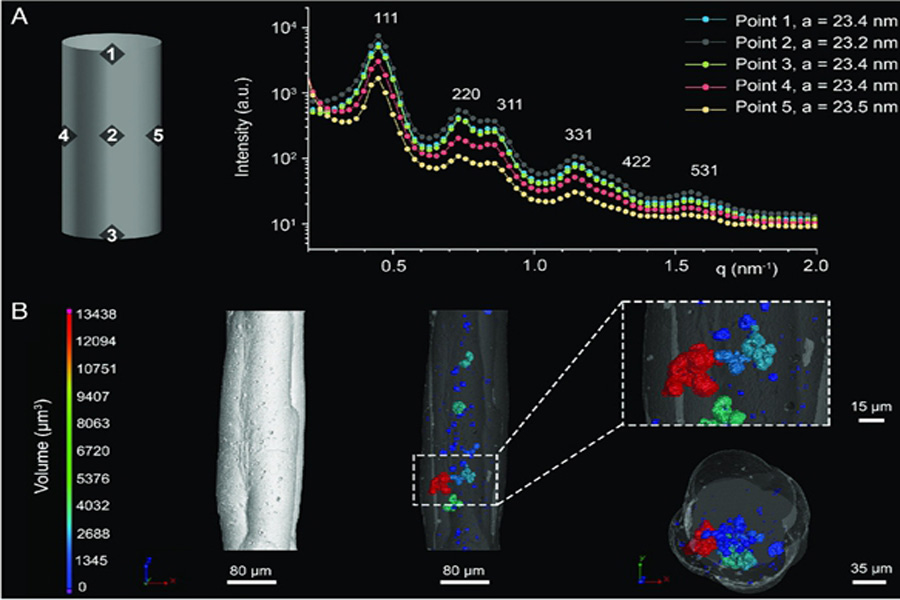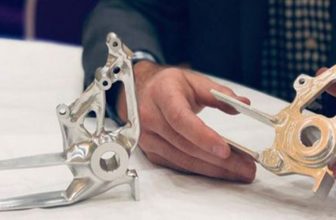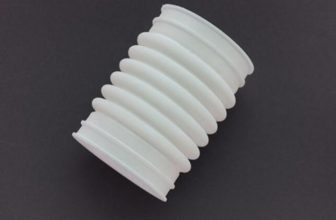
Researchers at the Technical University of Hamburg (TUHH) and the Massachusetts Institute of Technology (MIT), in collaboration with the Universities of Bremen and Bremen, have used 3D printing to assemble nanoparticles into robust macrostructures.
The research team developed a direct-write self-assembly technology, which is fully enhanced through cross-linking, so that the structural strength of the microstructure can be reflected in the macrostructure. Combining 3D printing with this colloidal assembly method can enable the development of stronger mechanical and multifunctional 3D structures, and open up new application areas for the resulting materials in the aerospace industry. “3D printing provides a fast and controllable way to develop new materials. Previous 3D printed particle-based materials are usually weaker because their particles are mainly held together by weak forces. And here, A strong, tightly packed network of covalently bonded nanoparticles is formed throughout the material.” said Dr. Berta Domènech of TUHH, who is in charge of this research.
Utilize the strength of microstructures
Macrostructures usually contain many cracks or defects, which may cause them to fail when placed under higher loads. On the other hand, nanomaterials have almost no defects, so incorporating the advantages of microstructures into their macro-equivalent potential can provide the latter with higher strength. In order to achieve this integration, a manufacturing method that can precisely control the composition and assembly of nanoparticles (NP) needs to be developed.
The researchers proposed that NPs can be assembled into larger structures by using and further controlling their inherent intermolecular and surface forces. Using these short-range forces, colloidal self-assembly becomes a feasible method, which can specifically design nano-blocks and adjust the properties of the resulting materials. Although colloidal self-assembly is commonly used to create 1D or 2D structures, 3D printing can be used to tailor 3D material systems across multiple length scales.
In order to effectively use this direct writing 3D printing technology, the research team will need to use shear-thinning ink, which flows through pinholes under pressure and has a shape-retaining ability during deposition. As a result, the successful bridging of several length scales depends on the inherent mechanical strength of the synthesized nanocomposite. Although the theoretical strength of NP is extremely strong, the bonding force between NPs needs to reach hundreds of MPa to work, so the team needs a new method. In response, the researchers devised a method that combines direct writing 3D printing with colloidal self-assembly of iron oxide NPs to create a solid, free-standing macrostructure.
3D printing high-strength macrostructure
The direct-write colloidal components were built using a custom desktop direct-write system, which was originally developed by the Massachusetts Institute of Technology. To create the structure, a toluene-based suspension of OA-functionalized Fe3O4-NP was dispensed from a high-precision needle onto the substrate to form a liquid bridge. During the colloid assembly process, the bridge provides a limit for the NPs gathered at the bottom and forms a self-assembled solid column. The process can be controlled by moving the substrate down at a rate that matches the vertical growth rate of the self-assembled printed column. Strength is enhanced by heat treatment in an inert atmosphere at 325°C, thereby forming new bonds (or crosslinks) between organic molecules of adjacent nanoparticles. The resulting organic parts are harder and more resistant to higher loads, and the curing effect is similar to the curing process on ordinary epoxy resins.
Using this new technology, researchers have produced a free-standing millimeter-sized column with a supercrystalline structure. It was found that the surface of micro-pillars composed of an ordered arrangement (supercrystalline) of spherical iron oxide nanoparticles was covered with short organic molecules (oleic acid). It was found that this surface functionalization is the reason for the enhanced mechanical properties of the material. The binding force allows the nanoparticles to be controllably assembled into a tightly packed, orderly arrangement, and organic molecules act as active sites to further enhance the material.
In order to evaluate possible changes in the superlattice, a synchrotron-based small-angle X-ray scattering (SAXS) analysis was performed at different points along the cylinder axis. The scan determined that a superlattice was formed, and no significant differences in the lattice parameters as a function of column position were detected. The abstract X-ray microscope (XRM) was applied to a part of the 3D printed column with a total length of 460μm. The scan detected asymmetrically distributed internal voids and pores inside the 41 311 μm3 chromatographic column, which is equivalent to 0.6% of the total estimated volume of the sample.
The research team successfully proved that the combination of colloidal assembly and 3D printing can easily and quickly create a sturdy and durable chromatographic column that bridges almost five different length ranges. According to the researchers, they will now try to gain more control over process parameters, expand the scope of research to other nanoparticle systems, and ultimately create 3D printed parts with different geometries. This new technology may lead to the integration of nanoscale building blocks into a variety of macro-multifunctional materials, from photonic devices to new structural materials.
High-durability macrostructures in 3D printing
Researchers from various government departments and academic institutions have devised new 3D printing methods that have produced more durable metals in recent years.
Researchers at Texas A&M University established a set of guidelines and parameters to allow low-alloy additive manufacturing as defect-free parts in March 2020. The team has developed a standard that can accurately determine the maximum distance between shadow lines, so as to avoid the lack of fusion between defective layers.
The US Air Force Institute of Technology (AFIT) developed a method for 3D printing high-performance Air Force AF-9628 steel for weapon applications in September 2019. Innovated a new type of powder bed fusion (PBF) technology, which can produce metals that exhibit higher tensile strength than traditional AM alloys.
In October 2019, the Marshall Space Flight Center (MSFC) of the National Aeronautics and Space Administration (NASA) became the first commercial customer of HRL Labs 7A77 aluminum 3D printing powder. This material is a development version of Al-7075, which has good ductility, high strength, toughness and excellent corrosion resistance.





